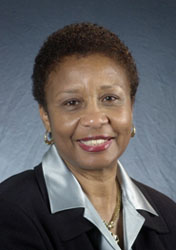The elderly population of the future may not look much like the old people of today. It will be less white and with fewer native English speakers. That means physicians, nurses, social workers and health aides will have to adapt to our increasingly diverse society, according to Peggye Dilworth-Anderson, professor, health policy & management, and interim co-director of the Institute on Aging at the University of North Carolina. She says that not understanding the “cultural context” of each patient can lead to inappropriate diagnoses and treatment and contribute to health disparities.
Dilworth-Anderson presented her research recently at the annual meeting of the Gerontological Society of America, and afterward spoke with reporter Liz Seegert. Here is the edited interview:
What does cultural competency in health care mean?
Many times, it comes down to trying to get inside the other person’s head, to find out where he or she is coming from, what the belief or value systems are, that make this person respond a certain way to health care.
What is the connection between cultural competency and health disparities?
One of the first steps in making sure there is equity in health care is to step back and look at the world from the patient, family, and caregiver point of view.
For example, older African American women belong to a culture that cherishes and protects them. So the family is very involved and wants to know that their mother or grandmother is treated with respect and dignity. This is also a culture that maintains a high degree of privacy and personal boundaries. It can be difficult at first to get an honest assessment of an elder person’s condition, because they may not be immediately forthcoming. Trust takes time to build, and care can be challenging until that comfort level is there.
You define “access to care” pretty broadly.
Where care is located – like in a neighborhood clinic, or big urban hospital or how easy it is to get to – is only part of the equation. It also involves how you’re treated when you get there, if providers understand your background and take it into account. Are they good at reading between the lines and interpreting what’s being said in light of your beliefs?
In Latino and African American cultures, multiple family members are part of the decision-making process, and want to be included in all conversations. That’s a difficult balancing act for providers because of HIPPA privacy regulations. So a patient has to waive privacy. There may also be a delay in getting a diagnosis or treatment for a condition like dementia, because in those cultures, it’s just considered a normal part of getting older.
Your research found that some minority caregivers are not taking advantage of all of the support services available to them. Why not?
If memory loss or agitation is just accepted as a natural part of growing older, these families probably would not take advantage of outside help.
Another piece of this is to look at where information about support services is available. A caregiver may not pick up a pamphlet in a doctor’s office, but if that same information was put in neighborhood gathering spots like beauty parlors or churches, it would be perceived as more trustworthy.
Not long ago, I was surveying an elderly African American patient and her caregiver, and other family members insisted on knowing the questions and answers. I had to understand that this was part of their culture, to know what was going on with this older person in their lives. If I hadn’t done that, there never would have been any trust between us.
What’s needed to improve cultural competency among health providers?
This really gets to improving workforce training. We’re teaching health providers with models developed 20 years ago that may no longer be relevant. We need to rethink what we perceive of as “normal” aging.
We need to look at how people are the same and how they’re different. For example, the Hmong, Vietnamese, and African American cultures all hold the elderly in high esteem. However, each group has certain ways of caring for them, according to their customs. We need to know this and respond appropriately.
We need fresh voices at the table. The policy process should include caregivers, and those representing families. It needs to be a more culturally-diverse group. We need to work within communities, to recognize and take advantage of support systems, where there is already a culture of trust. We also need to take a look at existing policies and revise them to reflect our world in 2012 and beyond.







